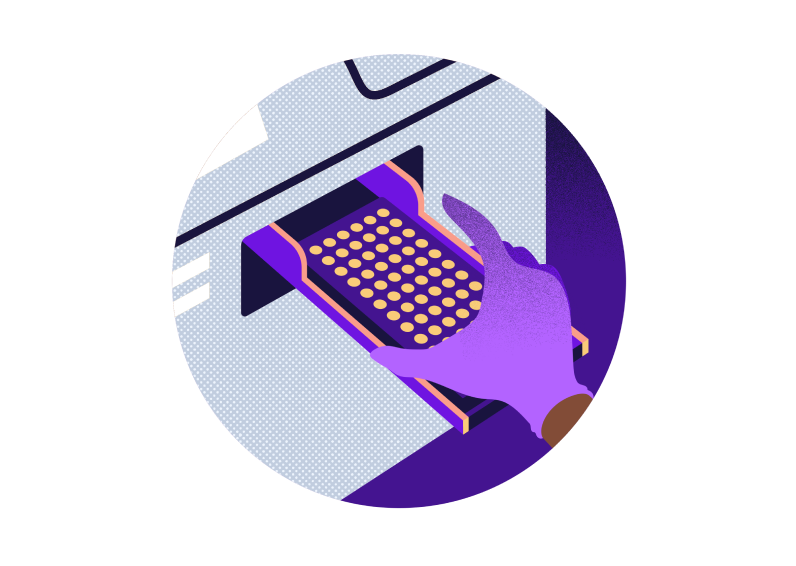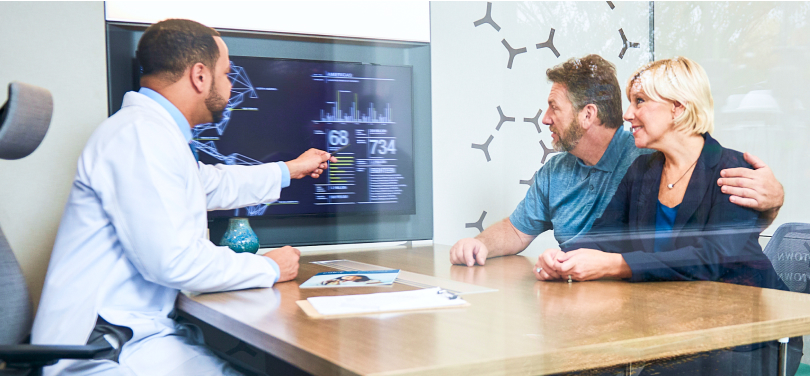Augment patient regimens with a clinical-grade genomics program

Genetic testing with comprehensive counseling programs
Color makes it easy to order and send genetic tests kits to patients at home. Get actionable results and access to our board-certified genetic counselors.
An affordable, actionable, and accessible solution
Patient-focused testing
Color’s low self-pay price and complimentary access to our genetic counselors make testing accessible for your patients.

Medically-actionable results
Our reports integrate relevant guidelines to help you develop a personalized screening and prevention plan for your patients.

Clinical-grade quality
Our validated test is performed in our CAP-accredited and CLIA-certified lab using Next Generation Sequencing methods and customized software tools.

3 Tests to Choose From, 1 Patient Experience
All Color tests include ongoing access to physician support services, along with results from Color Discovery, which offers other engaging insights.

Hereditary Cancer
Genetic risk analysis of the genes associated with 8 common hereditary cancers

Color Standard

Color Extended
Genetic risk analysis of the genes associated with common hereditary cancers, hereditary forms of heart disease, and medication response
Guide choices for health and prevention with Color’s genetic test.
Heart
Cancer
Medications

Testing relatives is important
Color is offering genetic testing to parents, siblings, and adult children of people with mutations for just $199. This program is designed to help your patients who have known mutations get affordable testing for their first-degree relatives.
Enroll your eligible patients by uploading either your patient’s, or your patient’s relative’s, positive report below.
Color partners with leading institutions.
Learn more about the benefits and limitations of genetic testing.
This means a mutation associated with hereditary cancer was identified. It’s important to share your results with your provider to create a personalized healthcare plan.
It is common to see a genetic change that requires further research to determine if it is associated with an increased risk for developing hereditary cancer. To date, most of the variants of uncertain significance that are further classified have been found to be harmless, though this process can sometimes take years.1
1. Richards S, Aziz N, Bale S, et al. Standards and guidelines for the interpretation of sequence variants: a joint consensus recommendation of the American College of Medical Genetics and Genomics and the Association for Molecular Pathology. Genet Med. 2015;17(5):405-23.
Most cancers are “sporadic,” or seemingly due to random chance and without an identifiable cause. But about 10-15% of certain cancers are due to harmful genetic changes, called mutations, that are passed down through families. 2, 3, 4, 5
2. Tung N, Battelli C, Allen B, et al. Frequency of mutations in individuals with breast cancer referred for BRCA1 and BRCA2 testing using next-generation sequencing with a 25-gene panel. Cancer. January 2015;121(1):25-33. Pubmed Abstract.
3. Pal T, Permuth-Wey J, Betts JA, et al. BRCA1 and BRCA2 mutations account for a large proportion of ovarian carcinoma cases. Cancer. December 2005;104(12):2807-16. Pubmed Abstract.
4. Claus EB, Risch N, Thompson WD, et al. The calculation of breast cancer risk for women with a first degree family history of ovarian cancer. Breast Cancer Res Treat. November 1993;28(2):115-20. Pubmed Abstract.
5. Risch HA, McLaughlin JR, Cole DE, et al. Prevalence and penetrance of germline BRCA1 and BRCA2 mutations in a population series of 649 women with ovarian cancer. Am J Hum Genet. March 2001;68(3):700-10. Pubmed Abstract.
Knowing that you have a mutation that increases your risk of developing cancer allows you and your healthcare provider to create a personalized screening plan, which increases the chance of early detection. This is important because detecting cancer at its earliest stage improves the likelihood of a favorable outcome.6
6. SEER Stat Fact Sheets: Breast Cancer. Published November 2013. National Cancer Institute.
A positive result, or finding a mutation, is not a cancer diagnosis, and does not mean that you will develop cancer. For example, most women have a 10% chance of getting breast cancer by the time they are 80, while a woman with a mutation in the BRCA1 gene can have up to an 81% chance.7 Most men have a 2% chance of getting colorectal cancer by the time they are 70, while a man with a mutation in the MLH1 gene can have up to a 41% chance.8, 9 The level of increased cancer risk differs from gene to gene.
7. Antoniou A, Pharoah PD, Narod S, et al. Average risks of breast and ovarian cancer associated with BRCA1 or BRCA2 mutations detected in case Series unselected for family history: a combined analysis of 22 studies. Hum Genet. May 2003;72(5):1117-30. Pubmed Abstract.
8. Bonadona V, Bonaïti B, Olschwang S, et al. Cancer risks associated with germline mutations in MLH1, MSH2, and MSH6 genes in Lynch syndrome. JAMA.2011;305(22):2304-2310.
9. Dowty JG, Win AK, Buchanan DD, et al. Cancer risks for MLH1 and MSH2 mutation carriers. Hum Mutat. March 2013;34(3):490-7.
This means a mutation associated with hereditary cancer was identified. It’s important to share your results with your provider to create a personalized healthcare plan.
It is common to see a genetic change that requires further research to determine if it is associated with an increased risk for developing hereditary cancer. To date, most of the variants of uncertain significance that are further classified have been found to be harmless, though this process can sometimes take years.1
1. Richards S, Aziz N, Bale S, et al. Standards and guidelines for the interpretation of sequence variants: a joint consensus recommendation of the American College of Medical Genetics and Genomics and the Association for Molecular Pathology. Genet Med. 2015;17(5):405-23.
Most cancers are “sporadic,” or seemingly due to random chance and without an identifiable cause. But about 10-15% of certain cancers are due to harmful genetic changes, called mutations, that are passed down through families. 2, 3, 4, 5
2. Tung N, Battelli C, Allen B, et al. Frequency of mutations in individuals with breast cancer referred for BRCA1 and BRCA2 testing using next-generation sequencing with a 25-gene panel. Cancer. January 2015;121(1):25-33. Pubmed Abstract.
3. Pal T, Permuth-Wey J, Betts JA, et al. BRCA1 and BRCA2 mutations account for a large proportion of ovarian carcinoma cases. Cancer. December 2005;104(12):2807-16. Pubmed Abstract.
4. Claus EB, Risch N, Thompson WD, et al. The calculation of breast cancer risk for women with a first degree family history of ovarian cancer. Breast Cancer Res Treat. November 1993;28(2):115-20. Pubmed Abstract.
5. Risch HA, McLaughlin JR, Cole DE, et al. Prevalence and penetrance of germline BRCA1 and BRCA2 mutations in a population series of 649 women with ovarian cancer. Am J Hum Genet. March 2001;68(3):700-10. Pubmed Abstract.
Knowing that you have a mutation that increases your risk of developing cancer allows you and your healthcare provider to create a personalized screening plan, which increases the chance of early detection. This is important because detecting cancer at its earliest stage improves the likelihood of a favorable outcome.6
6. SEER Stat Fact Sheets: Breast Cancer. Published November 2013. National Cancer Institute.
A positive result, or finding a mutation, is not a cancer diagnosis, and does not mean that you will develop cancer. For example, most women have a 10% chance of getting breast cancer by the time they are 80, while a woman with a mutation in the BRCA1 gene can have up to an 81% chance.7 Most men have a 2% chance of getting colorectal cancer by the time they are 70, while a man with a mutation in the MLH1 gene can have up to a 41% chance.8, 9 The level of increased cancer risk differs from gene to gene.
7. Antoniou A, Pharoah PD, Narod S, et al. Average risks of breast and ovarian cancer associated with BRCA1 or BRCA2 mutations detected in case Series unselected for family history: a combined analysis of 22 studies. Hum Genet. May 2003;72(5):1117-30. Pubmed Abstract.
8. Bonadona V, Bonaïti B, Olschwang S, et al. Cancer risks associated with germline mutations in MLH1, MSH2, and MSH6 genes in Lynch syndrome. JAMA.2011;305(22):2304-2310.
9. Dowty JG, Win AK, Buchanan DD, et al. Cancer risks for MLH1 and MSH2 mutation carriers. Hum Mutat. March 2013;34(3):490-7.
